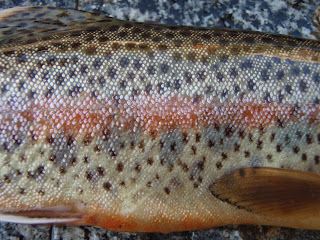
During my John Muir Trek between South Lake and Tuolumne Meadows, I
was fortunate to fly fish some of the most exhilarating and technically challenging streams in the
"Range of Light."
One that ranks for me as the most stellar of wild trout habitats is the
South Fork of the San Joaquin River. First, the terrain is very exciting, from
Goddard Canyon to the confluence with
Piute Creek, much of the access requires a "sixth sense" or
"ballerina awareness" while carrying your rod and gear. Climbing over
talus and polished granite benches is a skill set to access the many
exquisite pools, tail outs and countless riffles. It's understandably
apparent once you hook into one of these wild trout, that they are a
product of this environment. Feisty and strong, these hybrids would
hammer the fly, then propel themselves out of the water, to then
vigorously swim upstream and launch themselves out of the water again
often two feet into the air. Angling one these inspired fish with my
3wt rod was like equating it to a "pinball rodeo." Wow! Just hang on!
Tight line!
Even at this high elevation, roughly 9,000 feet, the fourteen trout I
caught and released were an average size of twelve inches nose to
tail. It was obvious that high biomass and the water purity that
flows from many alpine catch basins at the headwaters are definite
causes to their size and spirited strength. These well-fed trout, I'm
calling Cuttbows, rather than Paiute Cutthroats, have striking
coloration, heavy spotting, evident parr marks and distinctive red
stripe while lacking the slash under the jaw. (See Sierra Trout Guide
by Ralph Cutter, pg 15).
During my energetic scramble up this freestone stream, I found
abundant amounts of Cased Caddis and some large March Brown Stonefly
Nymphs which resembled ones I have found on the Lower Yuba east of
Marysville in northern California. During the day that I had to
investigate this stream, I thrived on the remoteness and grandeur
that complimented this rugged river. Most of the fishing technique
was high stick nymphing with a BB amount of weight. Before the trek,
I tied a few ginger "Hares Ear's," with gold ribbing, and a small
piece of holo-graphic tape over the thorax, that closely resembles
the Cased Caddis flies I have found crawling over the rocks in most
of theses streams. This fly worked very well and was one of the most
productive flies I tied for the trip. From any trail head the upper
South Fork is a least a two-day strenuous adventure on trail in the
wilderness, however as you loose yourself in the scenery and quality
of angling, the distance will seem to fade away.

No comments:
Post a Comment